R. rhombea (Salm-Dyck) Pfeiffer (Cereus rhombeus Salm-Dyck,
Hort. Dyck.: 341. 1834).
This name cannot be typified and in herbaria, the literature and
living collections it has been, and continues to be used in a multitude
of senses, including R. crispata (Haworth) Pfeiffer, R.
occidentalis Barthlott & Rauh, R. pachyptera Pfeiffer,
R. elliptica K. Schumann and R. oblonga Loefgren.
Its use should be abandoned and ideally it should be formally rejected
under the provisions of the International Code.
Rhipsalis rhombea (Salm-Dyck) Pfeiffer, Enum. Cact. 130.
1837.
Cereus rhombeus Salm-Dyck, Hort. Dyck. 341. 1834.
Hariota rhombea Lemaire, Cact. Gen. Nov. Sp. 75. 1839.
Detail from Britton & Rose
- Stems terete or angled
- branches usually flat and thin, but sometimes
3-angled
- joints oblong, 1 to 3 cm. broad, cuneate at base, strongly
crenate, dark green or purple
- flowers usually solitary at areoles
but sometimes in two, small, cream-colored, with a red spot at base
of stamens
- sepals reddish, petals obtuse
- fruit dark red
- type locality: Not cited.
- distribution: Brazil, but range unknown.
Cereus crispatus crenulatus, Epiphyllum crenulatum, and
E. rhombeum were referred by Pfeiffer (Enum. Cact. 130. :1837)
as synonyms of this species.
Here perhaps also belongs Cereus crispatus latior (Salm-Dyck,
Hort. Dyck. 66. 1834), which is without description.
Illustrations: Gartenwelt 16: 635; Karsten and Schenck, Vegetationsbilder
1: pl. 6, f. e; Mollers Deutsche Gart. Zeit. 25: 477. f. 11, No. 13;
Wildeman, Icon. Select. 2: pl. 67; Arch. Jard. Bot. Rio de Janeiro
1: pl. 16.
Plate xxxvi, figure 2, shows a flowering plant received from the Royal
Botanical Garden at Kew in 1902 which flowered in the New York Botanical
Garden in January 1912.
Rhipsalis rhombea (SD.) Pfeiff. (4)
Detail from Backeberg
Body shrubby, erect at first, then hanging, branching, to 80 cm long.,
main stems terete or with winged angles; shoots in 2's, 3's or more,
with 2 angles or 3 wings, ovate to lanceolate-rhombic, obtuse above,
taper¬ing and stem-like below, 3-12 cm long., to 5 cm broad, deeply
notched, Mid rib robust, intense to dark green, often reddish; Areoles
with sparse felt, some¬times with 1 bristle; Flowers c. 1 cm long.,
light to later canary-yellow, also reported as being whitish¬greenish;
Ovary spherical; Fruit dark red.
Brazil (coastal zone, Sao Paulo and Rio de Janeiro).
Photo taken at
Huntington Botanical Garden 9/99, KAF.
Previous Page
